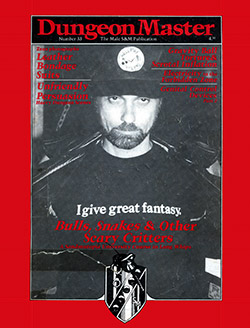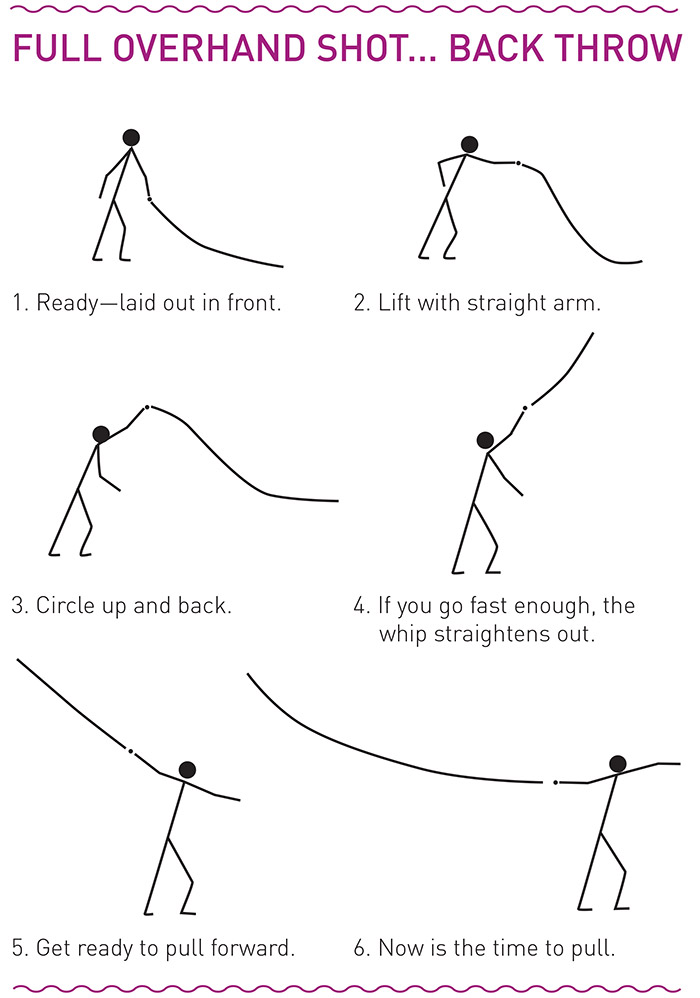By Jim the Whip Maker and Dick Carlson
Part 1: Bulls, Snakes & Other Scary Critters
Part 2: Swing & Target Practice
Part 3: Long Whips
Part 4: The First Crack
Part 6: The First Useful Shot – The Pick Up
Part 7: The Real Thing – The Single Side Shot
Part 8: For the Whip Top – Dealing with Your Whip Bottom
Part 9: For the Whip Bottom – Dealing with Your Whip Top
Part 10: A Word on Cuts for Whip Bottoms
We might try one more beginner’s shot. This is called the full overhand shot (by me, at least), and goes directly from behind to the front in a straight line, more or less. We’ll learn this one in two parts.
The shot begins with the whip at your feet and trailing out on the ground to the front. First, we transfer it to the rear. Keeping your elbow straight, swing your arm, elbow straight, in a vertical arc up from the front, over your head and to the rear. The idea is to get the whip to turn overhead like the spoke of a wheel, landing on the ground straight out behind you. Try this a couple of times. The whip should be nearly straight all the way. Go fast enough to make the whip pull quite strongly in your hand.
The second part completes the shot.
For this, it is necessary to pull the whip to the front as it goes through the horizontal behind you, and before it reaches the ground. This is all a matter of timing and, of course, practice. (Come to think of it, how would you push a whip anyway?)
When you start the move to the front, your arm should be fully extended behind you, palm up. You must bring your hand forward in a dead straight line at shoulder level, but a little out to the side, little finger first, palm inverted as it passes your shoulder. The whip is travelling buttfirst during the pull, so with the loose grip that you are now cultivating, the button should lead the way, the whip straight as possible.
When you fully extend your arm to the front, allow your hand to turn over, so that the handle points directly ahead. Hold this position as the whip comes past. The effect is that as your hand comes to a stop and the whip starts to overtake it, you throw a curl into the whip, folding it in half and re-extending it out in front as the curl runs down to the point. As more of the whip is in the standing part and less in the moving part, the moving part accelerates (Newton’s Law on the Conservation of Energy, I think). As the curl reaches the end of the whip, the speed exceeds that of sound and… bang!… the whip cracks.
Once you succeed, you’ll have it. Remember to keep the hand slightly out to the side during the shot to give the whip room to come by and miss you. If you are hit, it is still moving relatively slowly at that point, so it is not dangerous. And, it is coming from the rear, so it will not hit your face. If you hit the ground in front before the crack, aim higher or wait a little longer before you pull. If you cannot get a crack, you may be trying too hard. Relax and run through it a little more slowly.
You should combine the two parts of the shot into one smooth motion, the key to the whole thing. Do not jerk or cut back, or it will start back again before coming to rest and may hit you in the face. You will find that when you have it down pat, it takes almost no effort at all. After the crack, the whip should fall to the ground in front, pretty much where it started. This being so, the shot can be repeated as often as desired.
Again, this shot is not very useful, except to give a loud crack and to give you a feel for your whip. It is safe and easy though.
YOUTUBE TUTORIAL
April Jennifer Choi – Overhand Flick
Videos on the Overhead Crack, Reverse Overhead Crack and a range of other throws have been curated in Robin Doood’s article Basic Whip Tutorials for Sport Cracking and Scene Play
ABOUT THE AUTHOR
 This article first appeared in DungeonMaster magazine, Number 33, September 1987 published by Desmodus Publications and edited by Fledermaus (Tony DeBlase).
This article first appeared in DungeonMaster magazine, Number 33, September 1987 published by Desmodus Publications and edited by Fledermaus (Tony DeBlase).
Jim the Whip Maker and Dick Carlson taught this material as a course for the now defunct SandMutopia University, which was founded and operated by Tony DeBlase.
DungeonMaster was published from 1979 to 1992. After Tony DeBlase bought Drummer magazine in 1986, DungeonMaster became, in some ways, the little brother of its more popular stable-mate. Articles published in DungeonMaster were sometimes later reprinted in Drummer. In 1992, Desmodus Inc., which then included Drummer, Mach, Tough Customers, DungeonMaster, The Sandmutopia Guardian and The Sandmutopia Supply Company, was sold to a Dutch corporation headed by Martjin Bakker, the owner of RoB Amsterdam stores and galleries. Tony DeBlase became Editor Emeritus and passed away in 2000.

